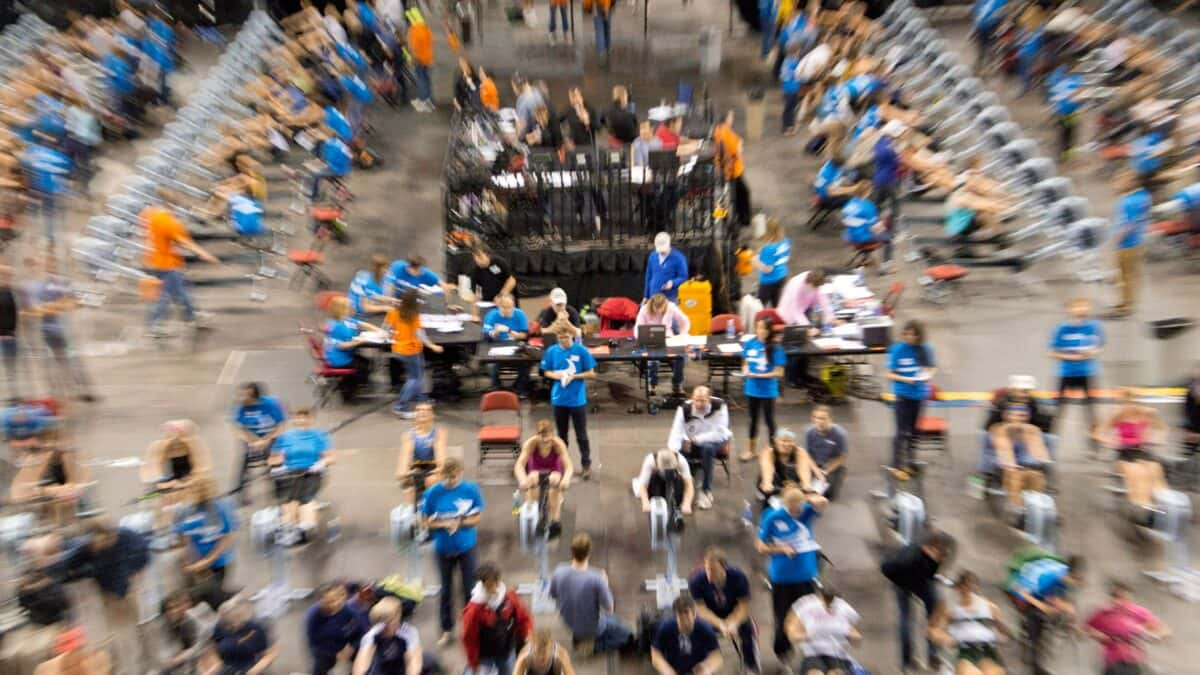
29 Oct 2014
The rise of the indoor rowing race
Believe it or not, the indoor rowing machine has been around for a good long while. Back in the 1800s a predecessor to today’s models already existed. It may not have looked pretty, but it gave rowers a chance to row inside when the weather outside was not favourable for rowing on the water. These early machines had no ability to measure the power output and machines had no consistency from one to another.
There was a large gap in the evolution of the indoor rowing machine before the Dreissigacker brothers at Concept2 in the United States came up with the Model A in 1981. This model could measure output and there was consistency between machines. The ability to race on one machine in comparison with another was born. American national team rower Tiff Wood, recognising the potential, told Andy Anderson in Rowing News: “Why not line up a bunch of the new Concept2 ergs and race? I just had an instinct that this made sense, that it could work.” In 1982 the first indoor rowing competition was held.
The competition took place at Harvard University’s Newell boathouse in Boston, USA. The race was five miles long and was held on the original Concept2 erg. The event was named C.R.A.S.H-Bs after a group of national team rowers – the Charles River All-Star Has-Beens – including Wood, who would look for a chance to race on the water as soon as possible at the end of winter. As there weren’t many races to enter they put an eight together and raced university crews.
About 12 people competed in this first event, known for its humour as much as its racing. “The $90 budget went almost exclusively on kegs of beer,” says present-day CRASH-B commodore Linda Muri. The winning prize has always been a hammer, a tongue-in-cheek way of describing someone who rows hard and aggressively. It was also Woods’ nickname.
Since CRASH-Bs began, indoor rowing competitions have sprouted throughout the world to the extent that they are now an integral part of the winter training season for on-water rowers. Computer programmes also allow indoor rowers to compete against other indoor rowers from any location.
A new breed of competitors developed as indoor rowing became a sport in itself. These competitors may never have set foot inside a rowing skiff and some have no desire to. Their sport is indoor rowing and each year they grow in numbers and become more competitive, especially with gyms now including indoor rowing classes in their workout programmes.
So what does CRASH-Bs look like today?
Held in February every year, this was its 31st year. Numbers have grown to nearly 2,300 competitors divided into a wide range of categories depending on age, gender and weight, with separate categories for adaptive rowers. From the original event which featured rowers in their twenties, the age span of competitors now stretches over nearly eight decades.
It is truly an international affair with competitors coming from more than 20 countries.
The venue Agganis Arena is huge, with 100 ergs in the warm-up room alone. High-tech Concept2 Model Ds are set up, ready to spin, with a huge screen showing race progression. The race distance has been standardised at 2,000m.
Amongst the 2,000-plus competitors there are many and varied stories on the reasons why they choose to put their body through a level of pain in the hope of winning a hammer. Petra Schallenberger flew in from Germany to compete in Boston this year. Schallenberger, 40, had decided to challenge herself by entering two events and thus submit to two 2,000m races.
Why? “In my age category it’s not so hard, so I wanted to try another age group. I’ve gone 7:15 (at CRASH-Bs in 2011), so I wanted to see what I could do,” says Schallenberger.
Schallenberger finished first in the 40-49 lightweight women’s category. She called this race her “warm-up” session. An hour later, she competed in the open lightweight category finishing sixth in a time of 7:22, four seconds faster than her earlier race.
“The races were definitely hard,” Schallenberger commented after her race. “A three to four hour break would have been nice.” Schallengerger has a high school background in water rowing but is on the water infrequently now with indoor rowing being her passion.
“Boston is the best event I’ve ever done. It’s very good, well organised,” says Schallenberger who has been at every CRASH-B event since 2005. “But I have never done two races before. In fact, I don’t think anyone has before.”
In the elite categories, the women’s open was won by Estonia’s Kaisa Pajusalu. This was Pajusalu’s fourth CRASH-B event and this year she did a personal best, winning in 6:37.3. Pajusalu fitted CRASH-B racing into her training for the Estonian national rowing team.
First in the men’s open category, Juan Carlos Cabrera, 20, travelled to Boston with the Mexican team. Like Pajusalu, Cabrera is also aiming for national team selection and erging is cross-training for his on-the-water training.
“I prefer to row on the water,” says Cabrera, “It’s where I have developed in rowing but it’s also true that I find the erg really good. Besides being good in the erg, I know I can improve in many aspects which I need, on the water.”
Cabrera was especially impressed by the atmosphere: “It was thrilling, and the noise is out of control. Inevitably it touches you deeply and you want to give your best. It’s hard on you, but you feel it less when racing is so tight and motivation exceeds any difficulty or fatigue.”
And how did Commodore Muri celebrate the end of another successful CRASH-B event? A 2,000m erg race with fellow organiser CB Sands-Bohrer. The day after… of course.
Melissa S. Bray

